- Joined
- Oct 9, 2007
- Messages
- 47,878 (7.38/day)
- Location
- Dublin, Ireland
| System Name | RBMK-1000 |
|---|---|
| Processor | AMD Ryzen 7 5700G |
| Motherboard | Gigabyte B550 AORUS Elite V2 |
| Cooling | DeepCool Gammax L240 V2 |
| Memory | 2x 16GB DDR4-3200 |
| Video Card(s) | Galax RTX 4070 Ti EX |
| Storage | Samsung 990 1TB |
| Display(s) | BenQ 1440p 60 Hz 27-inch |
| Case | Corsair Carbide 100R |
| Audio Device(s) | ASUS SupremeFX S1220A |
| Power Supply | Cooler Master MWE Gold 650W |
| Mouse | ASUS ROG Strix Impact |
| Keyboard | Gamdias Hermes E2 |
| Software | Windows 11 Pro |
GIGABYTE displayed their latest motherboards and graphics cards at the 2023 International CES, covering their Socket LGA1700 Intel 700-series chipset; and Socket AM5 AMD 600-series chipset. The Z790 AORUS Tachyon is the company's top-grade LGA1700 motherboard targeting the professional overclocking crowd. The board is designed to chase down CPU and memory overclocking world records, featuring the company's most powerful CPU VRM solution, and a 1 DIMM-per-channel DDR5 memory setup that preferred by overclockers for supporting the highest memory overclocks with the tightest timings. There are several overclocker-friendly features besides the onboard buttons—dual-BIOS ROMs, angled connectors for bench cases, consolidated voltage measurement points, and a feature-packed BIOS setup program.
Over in the AMD side, GIGABYTE's top Socket AM5 motherboard is the X670E AORUS Xtreme, which is a feature-packed motherboard with possibly the strongest CPU VRM solutions in the market for Ryzen 7000 processors, and with the best VRM cooling. In addition to the PCIe Gen 5 M.2 slot wired to the AM5 SoC, you get additional Gen 5 slots that subtract from the x16 PEG slot. The AORUS Xtreme also has the most feature-rich BIOS available among GIGABYTE's AM5 lineup. The B650I AORUS Ultra is a premium Mini-ITX Socket AM5 motherboard based on the AMD B650 chipset. Despite its compact size, it gives you a PCI-Express 4.0 x16 PEG slot, a Gen 5 M.2 slot, and two additional Gen 4 M.2 slots, besides the latest wired- and wireless connectivity. We also snapped the B650 AERO G motherboard targeting creators, and the mainstream B650 AORUS Elite AX.

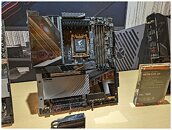
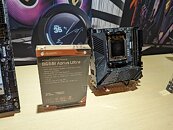
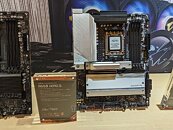

Among the graphics cards we spotted are the GeForce RTX 4070 Ti Gaming OC that we recently reviewed, and the feature-packed GeForce RTX 4070 Ti AORUS Master, which features GIGABYTE's highest factory-OC for this GPU at 2670 MHz GPU Boost (vs. 2610 MHz reference), and a tiny LCD display on the card that either puts out real-time monitoring, or can be made to display anything (eg: clan logo). The AORUS Master cooling solution also debuts GIGABYTE's newest "Bionic Shark" fans, which feature ridges that have "teeth," which can improve axial airflow. There's also the GeForce RTX 4080 AERO OC, a SKU that targets creators that like to game. Lastly, there's a custom-design AMD Radeon RX 7900 series graphics card, the Radeon RX 7900 XTX AORUS Elite.

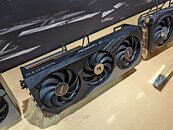
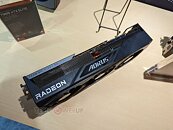
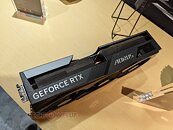
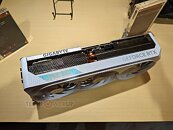
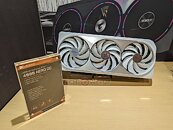
View at TechPowerUp Main Site
Over in the AMD side, GIGABYTE's top Socket AM5 motherboard is the X670E AORUS Xtreme, which is a feature-packed motherboard with possibly the strongest CPU VRM solutions in the market for Ryzen 7000 processors, and with the best VRM cooling. In addition to the PCIe Gen 5 M.2 slot wired to the AM5 SoC, you get additional Gen 5 slots that subtract from the x16 PEG slot. The AORUS Xtreme also has the most feature-rich BIOS available among GIGABYTE's AM5 lineup. The B650I AORUS Ultra is a premium Mini-ITX Socket AM5 motherboard based on the AMD B650 chipset. Despite its compact size, it gives you a PCI-Express 4.0 x16 PEG slot, a Gen 5 M.2 slot, and two additional Gen 4 M.2 slots, besides the latest wired- and wireless connectivity. We also snapped the B650 AERO G motherboard targeting creators, and the mainstream B650 AORUS Elite AX.





Among the graphics cards we spotted are the GeForce RTX 4070 Ti Gaming OC that we recently reviewed, and the feature-packed GeForce RTX 4070 Ti AORUS Master, which features GIGABYTE's highest factory-OC for this GPU at 2670 MHz GPU Boost (vs. 2610 MHz reference), and a tiny LCD display on the card that either puts out real-time monitoring, or can be made to display anything (eg: clan logo). The AORUS Master cooling solution also debuts GIGABYTE's newest "Bionic Shark" fans, which feature ridges that have "teeth," which can improve axial airflow. There's also the GeForce RTX 4080 AERO OC, a SKU that targets creators that like to game. Lastly, there's a custom-design AMD Radeon RX 7900 series graphics card, the Radeon RX 7900 XTX AORUS Elite.






View at TechPowerUp Main Site




